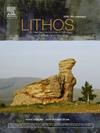Constraints of in-situ elemental compositions and U–Pb ages of cassiterite on the origin of the Cretaceous Gejiu and Dulong tin deposits, SW China: Implications for the linkage of tin belts in SE Asia
IF 2.9
2区 地球科学
Q2 GEOCHEMISTRY & GEOPHYSICS
引用次数: 0
Abstract
The western Yunnan tin belts in SW China and the southern Myanmar tin belt in SE Asia are traditionally thought to be part of the SE Asian tin metallogenic province. However, the tectonic setting of the Youjiang tin belt in SW China and its genetic relationship to the other tin belts are poorly documented. In this belt, the giant Gejiu and Dulong tin deposits are typical of skarn-type deposits and both contain contact and distal skarn orebodies. Tin ores of distal orebodies in these two deposits are composed of cassiterite, sulfide and calcite. In both deposits, most cassiterite grains from these ores are rich in Fe and W and depleted in Nb and Ta. They have 238U/206Pb ages between 81.4 and 84.1 Ma, similar to hosting granitic plutons. Two generations of cassiterite with distinctly different microtextures and trace elemental compositions can be recognized. The first generation (Cst-I) is compositionally and texturally homogeneous, but the second generation (Cst-II) displays distinctly oscillatory zoning. Cst-II contains Nb, W, and U lower, and Fe, Ta, Zr and chalcophile elements (Ga, Ge, In, and Sb) higher than Cst-I. These textural and compositional variations reflect the potential involvement of meteoric water in the magmatic-hydrothermal system. In this system, ore-forming fluids were evolved to more alkaline and oxidized to facilitate the precipitation of cassiterite. Our study indicates that these two deposits in the Youjiang tin belt have mineralization styles similar to those in the adjacent western Yunnan and southern Myanmar tin belts and all these tin belts belong to the SE Asian metallogenic provinces. A westward-younging trend of tin mineralization in these three belts can be explained by the rollback of the subducted Neo-Tethyan oceanic slab. This setting is different from the one related to the subduction of the Paleo-Pacific plate.
锡石原位元素组成和U-Pb年龄对中国西南部白垩纪地久和独龙锡矿床成因的制约:对东南亚锡矿带联系的影响
中国西南部的云南西部锡矿带和东南亚的缅甸南部锡矿带历来被认为是东南亚锡金属成矿省的一部分。然而,中国西南部右江锡矿带的构造背景及其与其他锡矿带的成因关系却鲜有记载。在该锡矿带中,巨大的革九锡矿床和独龙锡矿床是典型的矽卡岩型矿床,均含有接触矽卡岩矿体和远端矽卡岩矿体。这两个矿床远端矿体的锡矿石由锡石、硫化物和方解石组成。在这两个矿床中,这些矿石中的锡石颗粒大多富含铁和钨,而铌和钽含量较低。它们的 238U/206Pb 年龄介于 81.4 至 84.1 Ma 之间,与寄主花岗岩柱岩相似。可以识别出两代锡石,它们的微观结构和微量元素组成截然不同。第一代(Cst-I)在成分和质地上是均匀的,但第二代(Cst-II)则显示出明显的振荡分带。与 Cst-I 相比,Cst-II 的 Nb、W 和 U 含量较低,而 Fe、Ta、Zr 和亲钙元素(Ga、Ge、In 和 Sb)含量较高。这些纹理和成分的变化反映了岩浆-热液系统中可能有陨石水的参与。在这一系统中,成矿流体被演化成碱性和氧化性更强的流体,从而促进了锡石的沉淀。我们的研究表明,右江锡矿带的这两个矿床与邻近的云南西部锡矿带和缅甸南部锡矿带的成矿方式相似,这些锡矿带都属于东南亚成矿省。这三个锡矿带的锡矿化呈西向年轻化趋势,可解释为新泰西洋板块俯冲后退。这种环境与古太平洋板块的俯冲环境不同。
本文章由计算机程序翻译,如有差异,请以英文原文为准。
求助全文
约1分钟内获得全文
求助全文
来源期刊

Lithos
地学-地球化学与地球物理
CiteScore
6.80
自引率
11.40%
发文量
286
审稿时长
3.5 months
期刊介绍:
Lithos publishes original research papers on the petrology, geochemistry and petrogenesis of igneous and metamorphic rocks. Papers on mineralogy/mineral physics related to petrology and petrogenetic problems are also welcomed.
 求助内容:
求助内容: 应助结果提醒方式:
应助结果提醒方式:


